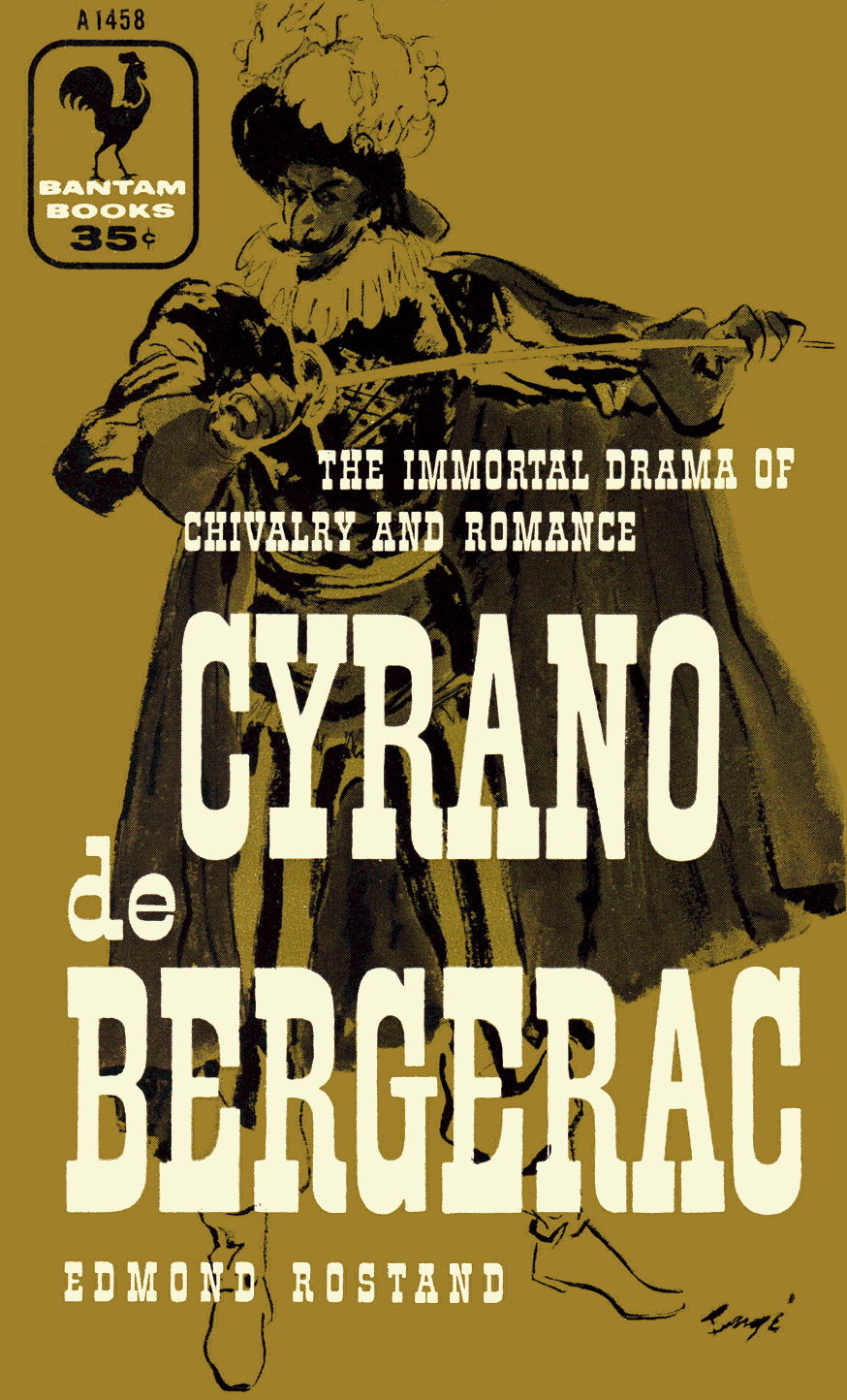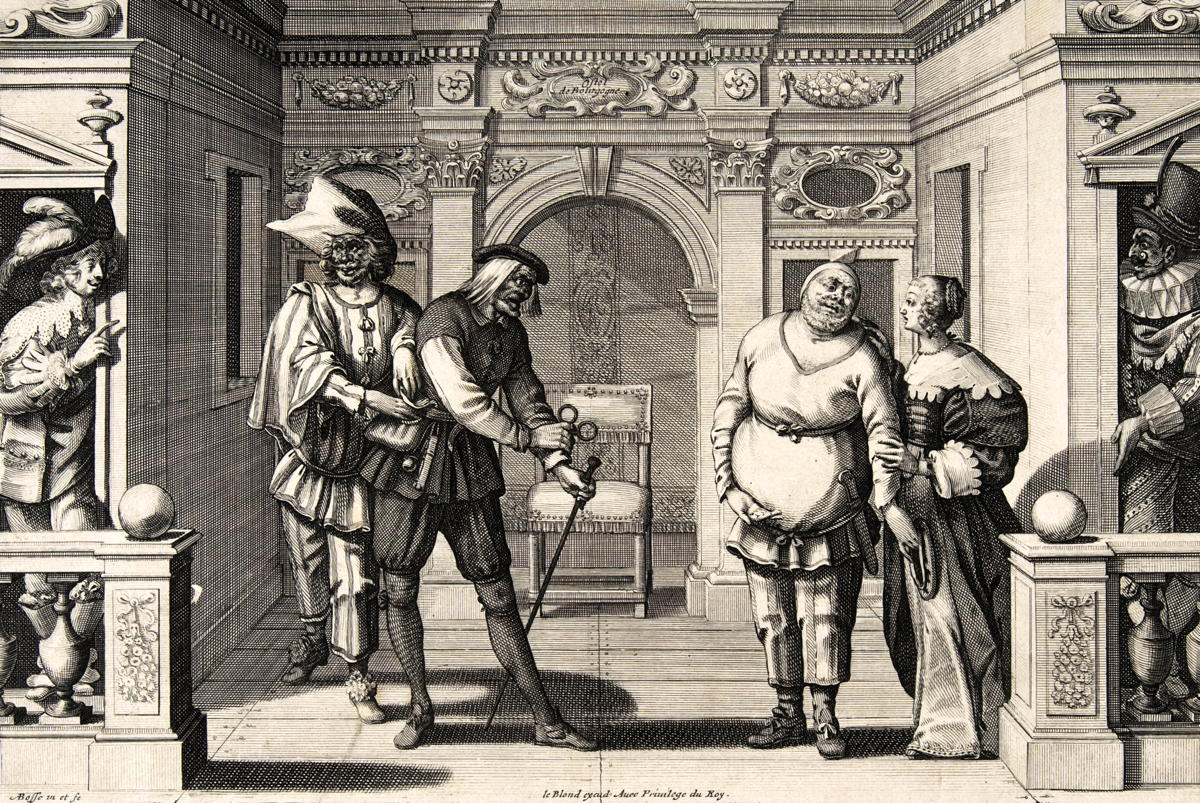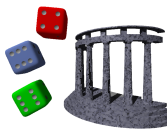Flashing Blades: En coulisse de l’Hôtel de Bourgogne

Last year in June I ran a session of Flashing Blades at the North Texas RPG Con, In September I published the dueling aid that I made up for the event. In this post I provide the simple reskin (PDF File, 122.7 KB) and pregenerated characters (Zip file, 36.6 MB).
The reskin was easy. I ran an only slightly modified version of The Grand Theater from Parisian Adventure. It’s a great choice for a one-shot and for a con game. There’s no real plot to it. It’s just an excuse to get into duels in a theater filled with rugs, candles, chandeliers, and Frenchmen. And one Englishman favored by a high-ranking cleric.
An English spy has stolen French naval documents, compromising France’s strength on the seas! More importantly, the King’s Musketeers and the Cardinal’s Guards are vying to restore the documents and capture the spy before their rivals. Get ready to swing from the chandeliers, fight the Cardinal’s guards—or the King’s musketeers—and outwit the enemies of France in Mark Pettigrew’s game of adventure, intrigue, and… flashing blades!
I renamed the adventure En coulisse de l'Hôtel de Bourgogne—Backstage at the Hôtel de Bourgogne—for the simple reason that I’d recently read Cyrano de Bergerac and the even simpler reason that some of the Bourgogne’s history in the period—I chose 1637 to put it right smack dab in Three Musketeers territory—is available online. While Jacob Latchkey is a fictional English spy required by the original Grand Theater adventure, the rest of the Comédiens du Roi are real actors and actresses of the Troupe Royale; they would have played at the Hôtel de Bourgogne during that period and they very possibly would have acted in Pierre Corneille’s La Place Royale.
In our session the actual plot of La Place Royale didn’t play into the adventure; it did, however, give me an idea of who would be running around backstage and what they would be doing at various points in the adventure. La Place Royale certainly provides a lot to take advantage of if you need it, however. It’s…
…a five-act comedy that tells the story of Alidor who tries to trick his fiancée Angélique into breaking their engagement. Alidor’s friend Cléandre is in love with Angélique who is in love with Alidor who is in love with himself. Alidor and Cléandre plant a fake love letter to a fictional Clarine where Angélique finds it, thinks it is from Alidor, and ends their relationship. Angélique’s friend Phylis sends her brother Doraste to catch her on the rebound before Cléandre can move in, and Angélique agrees to marry Doraste that evening. Alidor and Cléandre create a second plot to kidnap Angélique from a garden before the marriage, be seen spending the night with Cléandre, and so be forced to marry him. But their kidnappers take Phylis instead. Phylis and Cléandre fall in love, Angélique is devastated by how far Alidor is willing to go to be free of her and enters a convent, and Alidor is happily single.

Actors at the Hôtel de Bourgogne, painted about 1633-34.
A very modern farce. I’m sure I see Marcello Mastroianni as the lead.
As part of the reskin I’ve provided an introduction to be read to the players, one for the King’s Musketeers and one for the Cardinal’s Guards. I’ve also provided a few historical notes, and a cast list for La Place Royale.
I’ve provided several pregenerated characters (Zip file, 36.6 MB). Most are either Musketeers or Guards, but there are also a few spies and even a free agent.
I also made up a rules summary to help me run the game more quickly; I’ve included it in the notes file (PDF File, 122.7 KB) along with the dueling aid. The dueling system of Flashing Blades is conceptually very simple, but it does consist of some slightly more complicated ideas than, say, D&D, because of its focus on duels. The combat system features light wounds vs. serious wounds, a potential parry of every attack, and special counter actions.
Combat is handled in a way that makes it an actual duel. If you’ve ever played En Garde, it’s basically En Garde with a roleplaying game attached. When dueling, each participant says what they’re doing for each phase; there are two phases per turn. Who goes first depends first on their chosen action type: Movement goes first, Attacks next, then Defense, then Counter, and finally Miscellaneous actions. And if both sides choose an attack, missiles go first, then pollards, then dueling weapons, then other weapons, ending with unarmed attacks.
If the unarmed attacker is still alive at that point, of course.
It’s a fun system, whether played for laughs or played seriously like poker or chess, each side trying to guess what the other side is about to do.
You can of course use the pregenerated characters (Zip file, 36.6 MB) and the cheat sheet (PDF File, 122.7 KB) in any Flashing Blades game. The reskin notes (PDF File, 122.7 KB) won’t make much sense without Parisian Adventure. However you use it, I hope you enjoy it half as much as I did!
In response to Dueling aid for Flashing Blades: Dueling is one of the many fun aspects of the Flashing Blades RPG. This dueling aid will help players choose their opponent, their two actions, and their parrying guess.
downloads
- Dueling aid for Flashing Blades
- Dueling is one of the many fun aspects of the Flashing Blades RPG. This dueling aid will help players choose their opponent, their two actions, and their parrying guess.
- En coulisse de l'Hôtel de Bourgogne notes (PDF File, 122.7 KB)
- Reskin notes for turning The Grand Theater into En coulisse de l'Hôtel de Bourgogne, with dueling aid and Flashing Blades cheat sheet.
- Flashing Blades Pregenerated Characters (Zip file, 36.6 MB)
- Pregenerated Cardinal’s Guards and King’s Musketeers for En Coulisse de l’Hôtel de Bourgogne, a Flashing Blades convention adventure.
Flashing Blades
- Flashing Blades: Mark Pettigrew at Fantasy Games Unlimited
- “It was a question of honor, and honor was always foremost in the minds of the men who strode through the age of the Sun King. A deserted courtyard on the edge of Paris was the stage on which they met with… FLASHING BLADES.”
- Parisian Adventure: Mark Pettigrew at Fantasy Games Unlimited
- “The first adventure pack for use with FLASHING BLADES. Included in this package are four complete adventures and several bonus sections.”
- Review: Flashing Blades: Jerry Stratton at Jerry@Goodreads
- Mark Pettigrew’s Flashing Blades is a grand example of the gems waiting in old-school roleplaying games.
- Review: Parisian Adventure: Jerry Stratton at Jerry@Goodreads
- Parisian Adventure is an essential companion to Flashing Blades. It contains great excuses for dueling as well as new equipment and more detailed locations.
games
- En Garde!
- “Being in the Main a Game of the Life and Times of a Gentleman Adventurer and his Several Companions.”
- North Texas RPG Con
- “The NTRPG Con focuses on old-school Dungeons & Dragons gaming (OD&D, 1E, 2E, or Basic/Expert) as well as any pre-1999 type of RPG produced by the classic gaming companies of the 70s and 80s (TSR, Chaosium, FGU, FASA, GDW, etc). We also support retro-clone or simulacrum type gaming that copies the old style of RPGs (Swords & Wizardry, Castles & Crusades, and others).”
Pierre Corneille
- The comedies of Corneille: Experiments in the comic: G. J. Mallinson at Internet Archive
- “Corneille’s comedies are clearly quite distinct from Classical traditions of the genre, and have roots in the pastorals and tragicomedies much in vogue at the time.”
- La Place Royale: Pierre Corneille at Internet Archive
- From “Oeuvres de P. Corneille”, volume 11.
seventeenth century
- 17th century cut and thrust swords: Matt Easton at Schola Gladiatoria
- “The best century for swords? Looking at the significance and importance of broadswords, backswords, military rapiers and walloons.”
- The Hôtel de Bourgogne at The Archive Theater Company
- “The first act of the play Cyrano de Bergerac is set in a 17th century theater in Paris called the Hôtel de Bourgogne… The real Hôtel de Bourgogne was built by the 1548 by Confrérie de la Passion as a venue for their religious drama… The theater then became a rental venue for traveling companies and was in continuous use until until it closed in 1783.”
- La Place Royale by Pierre Corneille—A rom com from the 17th century
- “Corneille, the classic playwright is not exactly famous for being fun. But La Place Royale, written in 1634, three years before Le Cid is definitely a rom com.”
- Paris Theater: Hôtel de Bourgogne: Gaston’s Hat at For Honor… and Intrigue
- “Theater and swashbuckling go together. Who can forget Cyrano’s duel set to rhyme or Scaramouche’s duel that begins with him on stage in mask and costume?”
- Review: Cyrano de Bergerac: Jerry Stratton at Jerry@Goodreads
- “There are things in this world a man does well to carry to extremes.” Witty, funny, and very swashbuckling, Rostand early sets up what it’s going to be like by having d’Artagnan walk on stage, say a single line, and walk off again.
More Flashing Blades
- L’Entreprenante l’Entreprenante: Mirror Universe Trek for Flashing Blades
- In the Mirror, Mirror parallel universe of the original Star Trek series, many of the pivotal moments in the history of the Federation happened in the opposite way. This includes the history of the Enterprise itself. This adventure takes place at the start of the Enterprise’s storied history as a naval vessel.
- Flashing Blades: Character Calculation Perl Script
- Needing a bunch of characters quickly, I wrote a Perl script to do the basic rolls and basic calculations, with an option for creating more experienced characters.
- Flashing Blades at North Texas, 2025
- I’ll be running Flashing Blades again at North Texas this year, in a game called l’Entreprenante l’Entreprenante, pitting 1705 Naval officers against 23rd century Mirror Universe Imperial Officers.
- Dueling aid for Flashing Blades
- Dueling is one of the many fun aspects of the Flashing Blades RPG. This dueling aid will help players choose their opponent, their two actions, and their parrying guess.
- Flashing Blades at NTRPGC 2024
- I’ll be running a game of Flashing Blades on Wednesday at North Texas 2024.
More seventeenth century
- The Musketeers
- What did it look like to be a musketeer? What was a musket, and what was war like?
